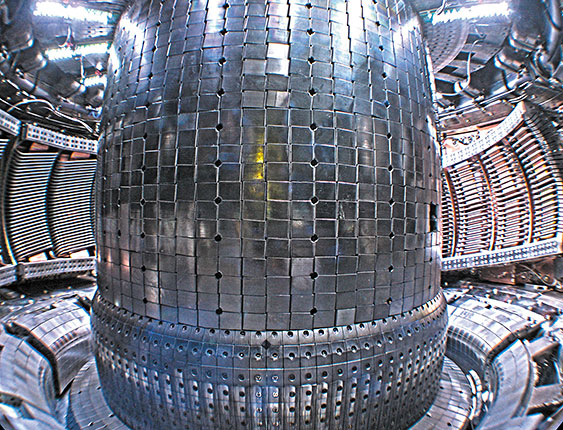Beams and plasmas
DOI: 10.1063/PT.3.4136
Plasmas are being studied for applications such as magnetic and inertial confinement fusion and in astrophysical phenomena. And accelerators, with their ever-increasing performance, are enabling new generations of light sources and the exploration of the frontiers of particle physics. By connecting those two scientific disciplines, researchers have learned that plasmas can support extremely large electric fields, which may be exploited to accelerate particles. Those fields can be generated using either intense lasers or particle beams to drive collective density waves, much like how a motorboat generates a wake on a lake’s surface.

The Alcator C-Mod tokamak at MIT uses a strong magnetic field to confine plasma for fusion energy applications. (Photo by Mike Garrett, CC BY 3.0

The successful combination of plasma and accelerator physics has resulted in the birth of new areas of research in which magnetized plasmas may be controlled to generate energy or in which light or particle beams are used to generate energetic particle beams, and those beams, in turn, are used to generate intense photon beams. In the past four decades, research with ever more intense laser and particle accelerator beams has increased our understanding of the interaction between ultra-intense light and matter. Those interactions arise from high-energy-density physics, nonlinear quantum electrodynamics, and radiation reaction forces, such as the creation of electron–positron pairs. The beams and plasma-physics section of Reviews of Modern Physics (RMP) has chronicled the key developments and, through its highly cited papers, has been an important partner in training the next generation of scientists.
Magnetized plasmas found in laboratory tokamak settings or as astrophysical plasmas in nature are rich in kinetic phenomena and particle-wave interactions. Researchers have been trying for a long time to harness the potential of controlled plasma fusion for energy production; the first experiments to use magnetized plasmas happened in the 1950s (see the article by David Pace, Bill Heidbrink, and Michael Van Zeeland, Physics Today, October 2015, page 34
How turbulence affects the magnetized plasma as it relaxes toward an equilibrium state continues to interest researchers (see the article by Richard Hazeltine and Stewart Prager, Physics Today, July 2002, page 30
Since the invention of the laser in 1960, nanosecond-duration laser pulses have progressed from containing tens of joules to megajoules of energy and have been used extensively to generate hot and dense plasmas. Scientists applied such technology to laser-driven, inertial confinement
7
and toward understanding astrophysically relevant, strongly coupled plasmas
8
in laboratory experiments
9
,
10
(see Physics Today, September 2015, page 16
The advent of ultra-intense femtosecond lasers has opened up access to new regimes of interaction between strong electromagnetic fields and plasma.
11
In the relativistic regime, the photon pressure exerted by the laser light can displace plasma electrons from ions. The resulting density waves that follow the laser pulse ripple through the plasma at velocities near the speed of light and support electric fields from a few to tens of gigavolts per meter; the electric fields can then accelerate electrons to high energies after they’ve traveled just a few centimeters
12
(see the article by Wim Leemans and Eric Esarey, Physics Today, March 2009, page 44
At even higher laser intensities, the radiation pressure can result in ion motion and the generation of high-energy ion beams from dense target materials. 16 At laser intensities exceeding 1023 W/cm2, nonlinear quantum electrodynamics phenomena emerge with electron–positron pair production and a breakdown of the vacuum when the field strengths approach the Schwinger field limit. 11 , 17
This brief summary does not mention several topics in plasma physics and its intersections with other branches of physics, including Penning traps that have been used in antihydrogen production, plasmas for nanoassembly processing, and laser manipulation and acceleration of electrons. 18 As knowledge of plasma physics and the progress in laser- and particle-beam technology advances to open new frontiers, we foresee a continuing presence of exciting topics in beams and plasmas in the pages of RMP.
References
1. F. L. Hinton, R. D. Hazeltine, Rev. Mod. Phys. 48, 239 (1976). https://doi.org/10.1103/RevModPhys.48.239
2. W. Horton, Rev. Mod. Phys. 71, 735 (1999). https://doi.org/10.1103/RevModPhys.71.735
3. N. J. Fisch, Rev. Mod. Phys. 59, 175 (1987). https://doi.org/10.1103/RevModPhys.59.175
4. J. B. Taylor, Rev. Mod. Phys. 58, 741 (1986). https://doi.org/10.1103/RevModPhys.58.741
5. M. Yamada, R. Kulsrud, H. Ji, Rev. Mod. Phys. 82, 603 (2010). https://doi.org/10.1103/RevModPhys.82.603
6. A. J. Brizard, T. S. Hahm, Rev. Mod. Phys. 79, 421 (2007). https://doi.org/10.1103/RevModPhys.79.421
7. K. A. Brueckner, S. Jorna, Rev. Mod. Phys. 46, 325 (1974). https://doi.org/10.1103/RevModPhys.46.325
8. S. Ichimaru, Rev. Mod. Phys. 54, 1017 (1982). https://doi.org/10.1103/RevModPhys.54.1017
9. B. A. Remington, R. P. Drake, D. D. Ryutov, Rev. Mod. Phys. 78, 755 (2006). https://doi.org/10.1103/RevModPhys.78.755
10. S. H. Glenzer, R. Redmer, Rev. Mod. Phys. 81, 1625 (2009). https://doi.org/10.1103/RevModPhys.81.1625
11. G. A. Mourou, T. Tajima, S. V. Bulanov, Rev. Mod. Phys. 78, 309 (2006). https://doi.org/10.1103/RevModPhys.78.309
12. E. Esarey, C. B. Schroeder, W. P. Leemans, Rev. Mod. Phys. 81, 1229 (2009). https://doi.org/10.1103/RevModPhys.81.1229
13. S. Corde et al., Rev. Mod. Phys. 85, 1 (2013). https://doi.org/10.1103/RevModPhys.85.1
14. C. Pellegrini, A. Marinelli, S. Reiche, Rev. Mod. Phys. 88, 015006 (2016). https://doi.org/10.1103/RevModPhys.88.015006
15. U. Teubner, P. Gibbon, Rev. Mod. Phys. 81, 445 (2009). https://doi.org/10.1103/RevModPhys.81.445
16. A. Macchi, M. Borghesi, M. Passoni, Rev. Mod. Phys. 85, 751 (2013). https://doi.org/10.1103/RevModPhys.85.751
17. M. Marklund, P. K. Shukla, Rev. Mod. Phys. 78, 591 (2006). https://doi.org/10.1103/RevModPhys.78.591
18. R. J. England et al., Rev. Mod. Phys. 86, 1337 (2014). https://doi.org/10.1103/RevModPhys.86.1337
More about the Authors
Wim Leemans now directs the accelerator division at DESY (German Electron Synchrotron) in Hamburg, after more than 27 years of research at Lawrence Berkeley National Laboratory in Berkeley, California.





